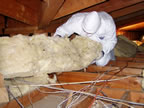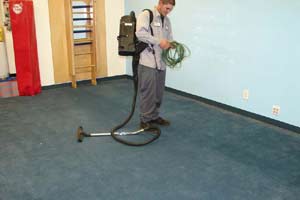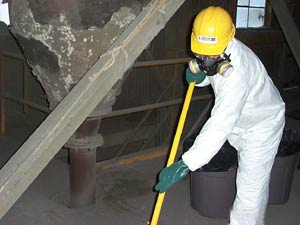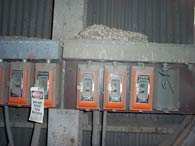![]()
![]()
![]()
Cash
&
Check
Call toll free 877-4ABOLISH 877-422-6547 |
|||
Attic Decontamination More on our Insulation Removal process Videos on Attic Decontamination Our Steps for Attic Decontamination: 1) Inspection - Before an attic decontamination can take place we must first inspect the structure. We analyze all entry points and estimate the manpower needed to completely decontaminate the infested structure. 2) Trapping/Removal - Once inspected, We must remove the pest from the premises. If it is a rat or mouse infestation, we must place snap traps or humane traps in order to trap the pests. If it is a raccoon, opossum, or any large animals, we only use humane traps 3) Proofing - We MUST proof if you want to avoid another infestation. Proofing is critical because any missed spot will be the entry point of any number of different pests. Inspection spots potential and all entry points to be proofed. 4) Decontamination - Can be a lengthy process depending on the wildlife infestation. We use Hepa filtered vacuums to further limit harmful airborne contaminants. The Attic Decontamination process is a three step process. -Spraying contaminated areas. In order to avoid airborne contaminates, contaminated areas must be sprayed before removal. It is essential to spray areas contaminated with feces, urine, body oils, grease, insects, parasites, pathogens, etc. Once the area has been cleared of contaminants we spray the area with with pesticides, deodirizers, and disinfectant. -Removal of feces and contaminated materials. We begin removing once the feces and contaminants have been sprayed. We must always wear respirators with hepa filters and protective clothing when handling biohazardous waste. -installing insulation we install new insulation after removal of contaminated insulation and contaminants.
Removing and trapping the pest in your attic is only part of the job. The other part is to prevent any more pests from returning. The way to do that is to pest proof and decontaminate. As most people may know, leaving an attic with foul smells is not only unpleasant it is also a danger to one's health. It also attracts other animals to your attic. That is why cleaning and decontaminating the attic after an infestation is crucial in preventing future infestations. If you attempt to clean the attic yourself, it is strongly recommended to have proper equipment. As part of Abolish's complete rodent, pigeon, and animal control, we offer trapping, removing, proofing, cleaning, and decontamination. As part of our attic decontamination process we vacuum any droppings, clean infected areas, and replace the infected insulation with new insulation. If feces is not cleaned then more rodents, animals, or birds may come and you may even have to deal with a stronger smell of a dead animal in your attic. Some of the common attic inhabitants are pigeons, rats, raccoons, possums, squirrels, and bats.
Industrial/Commercial Decontamination More on our pressure washing process In many cases with Industrial and Commercial Decontamination and cleanup jobs, the infestation and accumulation of feces is a result of years of ignoring the problem. The fact is that ignoring any infestation will result in costly repercussions. Health hazards to both employees and customers can result in costly medical bills and the deterioration of expensive equipment can be costly to repair or replace. Apart from cleaning and decontaminating, eliminating the pest and proofing the problem area is essential. Doing so prevents future infestations and thus avoiding expensive cleaning and repair costs. Decontamination costs should not be a routine if it does not need to be. Part of decontamination consists of properly removing and pressure washing certain areas. The bacteria, fungal agents and parasites found in pest droppings and nests can carry hosts with serious diseases, including histoplasmosis, encephalitis, salmonella, meningitis, toxoplasmosis and more.
|
|||
|
|
Complete Attic Decontamination Before we start Once the exposed areas have been sealed and covered we begin the feces and contaminated insulation removal Note - Any feces or other waste left under the insulation is vacuumed with a US government certified HEPA vacuum. Most companies use common household vacuums that blow harmful contaminants and infectious diseases through out the air and even through your home. Be sure the company that decontaminates uses a HEPA vacuum. (from http://www.westernsafety.com)
We also use a ULPA (Ultra low particulate air) filter to further contain harmful contaminants; 99.999% efficient at .12 microns. This filter is much more efficient than normal HEPA filters. Pesticide, Bactericide, Sanitize, Disinfect Decontaminating the area is essential to deter possible future rodent occupants. Check Photo Gallery to see more examples of attic decontamination. The longer animals have lived in your attic, the more contaminated it is, but even short-term attic use will leave behind odors and pheromones. We know that once animals leave their scent behind it attracts new animals. once the problem starts, it can easily become a consistent problem. |
||
|
|||
 |
|||
|
Complete Industrial/Commercial Industrial and commercial decontamination steps are similar as attic decontamination. The only difference is that a contaminated area is usually much larger. Our technicians work long hours cleaning and decontaminating in health hazardous zones. Before we start Cleaning Note - Any feces or other waste left under the insulation is vacuumed with a US government certified HEPA vacuum. Most companies use common household vacuums that blows harmful contaminants and infectious diseases through out the air and even through your home. Be sure the company that decontaminates uses a HEPA vacuum. (from http://www.westernsafety.com)
We also use a ULPA (Ultra low particulate air) filter to further contain harmful contaminants; 99.999% efficient at .12 microns. This filter is much more efficient than normal HEPA filters. Pesticide, Bactericide, Sanitize, Disinfect Decontaminating the area is essential to deter possible future rodent occupants. Check Photo Gallery to see more examples of attic decontamination. The longer animals have lived in your attic, the more contaminated it is, but even short-term attic use will leave behind odors and pheromones. We know that once animals leave their scent behind it attracts new animals. once the problem starts, it can easily become a consistent problem.
|
||
|
|||
|
|||
Prevention
Damage |
|||
Feces Clean-Up Equipment and Chemicals
Any feces or material that might be contaminated should be removed from the work area and should be disposed of or decontaminated properly and safely top avoid cross contamination or it could pose a health hazard. Before an activity is started, the quantity of material to be removed should be estimated. (If the approximate volume of dry bat or bird feces in a building can be estimated,) Requirements established by local and state authorities for the removal, transportation, and disposal of contaminated waste should be followed. Arrangements should be made with a landfill operator concerning the quantity of material to be disposed of, the dates when the material will be delivered, and the disposal location. If local or state landfill regulations define material contaminated as infectious waste, incineration or another decontamination method may also be required. Wearing personal protective equipment (PPE) The primary way to try to prevent histoplasmosis is to avoid places that may contain dirt contaminated with bird or bat droppings, such as in an attic or pigeon coop. Also, leave piles of bat or bird droppings alone unless you take precautions, such as wetting down the material with proper disinfectant, to prevent the contaminated dirt from becoming airborne. You should also wear PPE (Personal protective equipment) if working in a potential contaminated environment, which is known to contain bat or bird feces. To protect the employees of your work place, it is required that employees keep clear of the work site during decontamination. |
|||
home | specials | commercial | residential | service area Absolutely
no rights of distribution by sale or other transfer of ownership
or by rental, lease or lending, preparation of derivative works,
or reproduction, in whole or in part, is not granted. No text, graphics
or photos may be downloaded and used on another Internet site, without
express permission of AbolishPestControl. For information on obtaining
photo usage and rights, please see our contact
page. AbolishPestControl reserves the rights to actively protect
against infringement. |
|||






